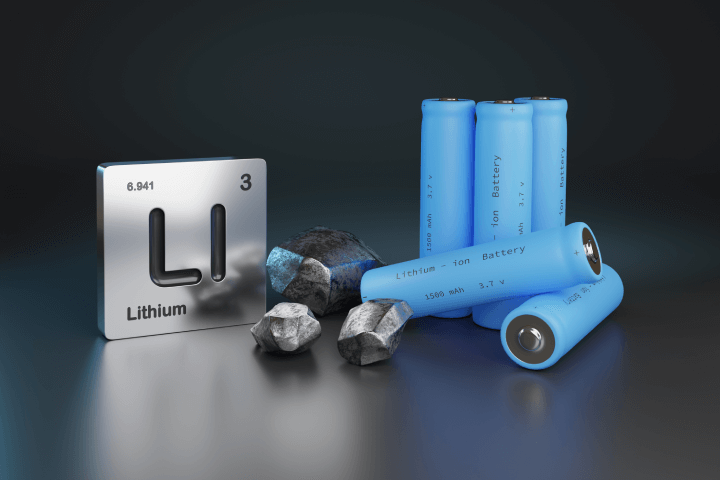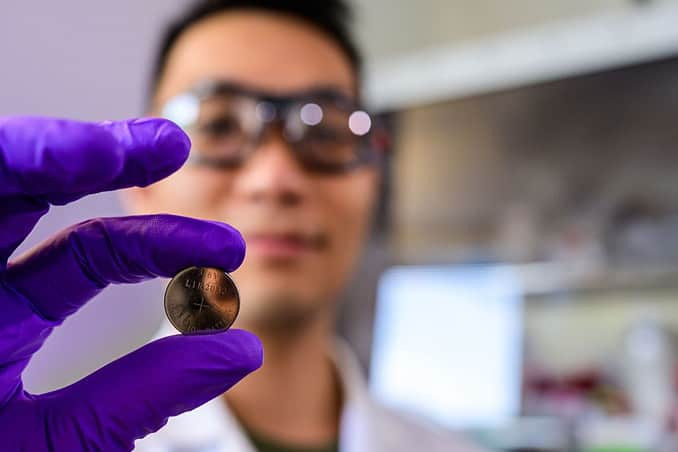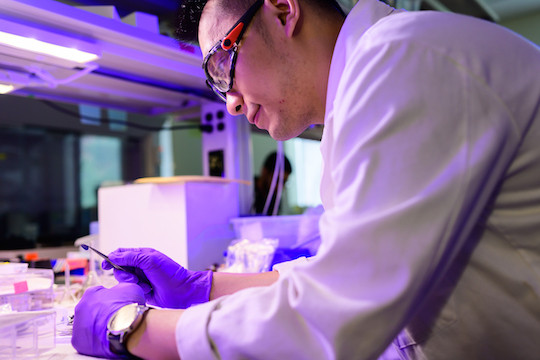Battery Technology Breakthrough: Extending Li-Ion Battery Life by 44%
In The News | 10-07-2023 | By Robin Mitchell
Lithium-Ion batteries dominate the electronics market thanks to their high capacity, high current capabilities, and small size, but for all their benefits, they suffer from a number of challenges. Recently, researchers from Rice University published their findings on a newly developed technology that can extend the battery life of a typical Li-Io battery by up to 44%. What challenges do Li-Ion batteries face, what did the researchers demonstrate, and how could this help engineers going forward?

What challenges do Li-Ion batteries face?
Compared to most other battery technologies, lithium technology has found itself to be the most popular in electronics, especially in portable devices such as smartphones, headphones, and even IoT devices. Their popularity stems from their extremely high energy density, meaning lithium batteries can be significantly smaller than other battery technologies. Not only does a smaller battery help to reduce the size of the device (something which is ideal for mobile devices), but a smaller battery also translates to less weight, and this is especially useful for applications such as drones.
But it isn’t just portable devices that have taken advantage of lithium; the entirety of the EV industry has recognised the advantages lithium-based batteries offer. Their high energy density and reduced weight allow for EVs to have a greater range, while the support for rapid charging and discharging allows for reduced charging times and greater vehicle acceleration.
However, lithium batteries are far from perfect, suffering from a number of challenges. The most famous by far is that lithium batteries can go catastrophically wrong, resulting in intensely hot fires that cannot be put out with water. Furthermore, lithium batteries that undergo damage can often release hydrogen gas, which makes them swell and further contribute to a disastrous end. This can happen if the battery is short-circuited or damaged, hence why such batteries require numerous amounts of protection mechanisms.
Another challenge that lithium-ion batteries face is their limited number of charge cycles. Simply put, every time a lithium battery is used, the battery is ever so slightly degraded, and this degradation gets worse with each charge cycle. One method to get around this issue is to never allow the battery to fully charge or discharge, but this results in a reduced energy capacity, thereby increasing the battery size, weight, and cost.
Even then, degradation can still occur, and this makes using lithium batteries in designs designed to operate for a long time a major challenge. In applications where power is required over a long period of time, engineers will typically look at other battery technologies, such as Nickle Cadmium (NiCa) which can last as long as 20 years.
Researchers extend Li-Ion battery life by 44%
Recognising the challenges faced with Li-Ion batteries, researchers from Rice University published their findings on a newly developed technology that helps to extend the life of Li-Ion batteries by up to 44%, using manufacturing processes that are already widely available.
To achieve this extended lifespan, the researchers turned to the anode that faces degradation with each charge cycle. Instead of going with a traditional anode material such as graphite, the researchers turned to a silicon anode as it is able to bond with far more lithium ions. However, this increased lithium-ion count also results in a solid-electrolyte interphase (SEI), meaning that lithium is used up during charge cycles, thereby affecting its lifespan.

Quan Nguyen is pictured with one of the batteries assembled using the prelithiation method outlined in the study. (Photo courtesy of Jeff Fitlow/Rice University)
According to the study published in ACS Applied Energy Materials, the researchers at Rice University, including Quan Anh Nguyen, Anulekha K. Haridas, Tanguy Terlier, and Sibani Lisa Biswal, used a surfactant to disperse the SLMPs evenly during the spray-coating process. This improved the coating’s distribution within the battery, preventing clumping and ensuring uniformity[1].
The researchers found that by using a surfactant during the spray-coating process, the resulting lithium spray was far more uniform. By having a uniform surface and consistency, lithium trapping cannot occur during multiple cycles, and the anode material is able to fully utilise its high energy density. Finally, the researchers were also able to carefully control the amount of lithium being applied to the anodes, thereby reducing the negative effects of using silicon as a base anode.

Quan Nguyen, who holds a doctorate in chemical and biomolecular engineering, is the lead author of the study. (Photo credit: Jeff Fitlow/Rice University)
The end result of the researcher’s findings was a li-ion battery technology whose life is 22% to 44%% greater compared to traditional types. While there are other challenges that the researchers need to address, it may be possible for this technology to be commercialised in the near future.
How could such a technology help engineers going forward?
The biggest effect of this technology is that it will enable engineers to reduce the size of batteries used in devices, and the reason for this comes down to how the life expectancy of li-ion batteries can be increased. For every full charge cycle, a battery degrades by some percentage, meaning that after so many charge cycles, the battery no longer becomes effective. However, if a battery is never allowed to fully charge or discharge, this degradation is significantly reduced.
As such, engineers will often put limits on how much a li-ion battery can charge and discharge, and while this may increase life expectancy, it reduces the effective energy storage of that battery. Thus, to compensate for this loss of energy storage, engineers make their li-ion batteries larger, resulting in a larger and heavier design.
If the technology developed by the researchers can be exploited, it would allow for batteries to be used closer to the extremes (complete charge and discharge). Therefore, a smaller battery can be used for the same lifespan, reducing the size, cost, and weight of that battery.
The Scalability of the Prelithiation Technique
The prelithiation technique developed by the researchers at Rice University is not only effective in extending the life of lithium-ion batteries but is also compatible with large-scale manufacturing. This compatibility with existing production processes is a crucial factor in ensuring that the benefits of this research can be realized on a wide scale. As the demand for energy storage solutions and electric vehicles continues to grow, this development could significantly contribute to the wider adoption of electric vehicles and a more sustainable energy future[3].
As noted by an expert opinion on Innovation Origins, this breakthrough in lithium-ion battery technology could have far-reaching implications. As the demand for energy storage solutions and electric vehicles continues to grow, the need for efficient and long-lasting batteries has never been more critical. The potential of silicon anode batteries to transform energy storage solutions is pivotal in addressing climate objectives and fully realising the capabilities of electric vehicles[3].
For now, all we can do as engineers is wait for the technology to be further developed, but considering that the researchers were able to demonstrate a significant improvement in battery life using manufacturing processes that are widely available makes this development truly exciting.
The Balance Between Maximising Battery Life and Avoiding Lithium Trapping
While the results of the research are promising, there are challenges that need to be overcome. For instance, excessive use of the coating can lead to more lithium trapping, causing the battery to fade more rapidly in subsequent cycles. This suggests that there is a delicate balance to be struck between maximizing battery life and avoiding lithium trapping. However, the researchers observed that by controlling the cycling capacity of the cell and optimizing the amount of SLMPs, lithium trapping can be avoided[3].
The researchers found that by controlling the cycling capacity of the cell and optimising the amount of SLMPs, lithium trapping can be avoided. This is crucial as excessive use of the coating can lead to more lithium trapping, causing the battery to fade more rapidly in subsequent cycles[2].
References
- Nguyen, Q. A., Haridas, A. K., Terlier, T., & Biswal, S. L. (2023). Prelithiation Effects in Enhancing Silicon-Based Anodes for Full-Cell Lithium-Ion Batteries Using Stabilized Lithium Metal Particles. ACS Applied Energy Materials. https://pubs.acs.org/doi/10.1021/acsaem.3c00713
- Rice University. (2023). New priming method improves battery life, efficiency. https://news.rice.edu/news/2023/new-priming-method-improves-battery-life-efficiency
- Innovation Origins. (2023). New technology boosts silicon li-ion battery life by 44%. https://innovationorigins.com/en/new-technology-boosts-silicon-li-ion-battery-life-by-44/

